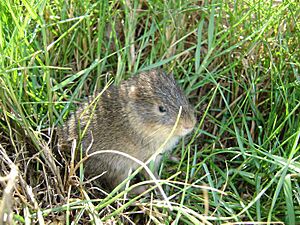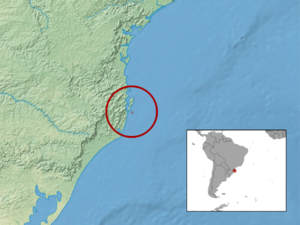Santa Catarina's guinea pig facts for kids
Quick facts for kids Santa Catarina's guinea pig |
|
|---|---|
 |
|
| Conservation status | |
| Scientific classification | |
 |
The Santa Catarina's guinea pig (Cavia intermedia) is a very rare type of guinea pig. It is also called the Moleques do Sul cavy. This special animal lives only in a small part of southeastern South America. It's one of the rarest mammals on Earth!
Contents
Where Does This Guinea Pig Live?
This little mammal lives only on the Moleques do Sul Archipelago. This is a group of small islands in Santa Catarina, southern Brazil. The islands formed about 8,000 years ago. There are three islands in total, but they are very small. Their total area is only about 10.5 hectares. To give you an idea, one hectare is about the size of a soccer field.
The Santa Catarina's guinea pig has one of the smallest homes of any mammal in the world. It lives in an area of only about 4 hectares! This small area is part of the Serra do Tabuleiro State Park. Even though it's a protected area, the rules to keep these guinea pigs safe are not always followed.
What Does the Santa Catarina's Guinea Pig Look Like?
The Santa Catarina's guinea pig is a type of rodent. It is about 20 to 40 centimeters long. That's roughly the length of a ruler! Unlike some other guinea pigs, the males and females are usually the same size.
These guinea pigs have bodies shaped like cylinders. Their fur can be brown or gray. They have short legs and long, coarse fur. The fur around their neck is even longer. You won't see an outside tail on these guinea pigs, just like most others. Their front teeth, called incisors, grow all the time. They keep them short and sharp by eating grass.
What Do They Eat and Where Do They Live?
The Moleques do Sul islands have a humid climate. Summers are hot, and it rains throughout the year, though less in winter.
These guinea pigs live in an area of about 6.34 hectares. This area is covered with plants that they love to eat. Their main food sources are two types of grass: Paspalum vaginatum and Stenotaphrum secundatum. The area where they actually eat is even smaller, only about 0.77 hectares. Bushes and other grasses like Cortaderia selloana and Verbesina glabrata grow around their feeding spots. These plants give the guinea pigs protection and places to hide.
These island guinea pigs grow up slower than other types of guinea pigs. Scientists can tell their age by looking at their bones. Young guinea pigs are small, weighing around 100-150 grams. Adult guinea pigs usually weigh more than 500 grams.
It's interesting that the baby guinea pigs can be quite large compared to their mothers. A baby can weigh up to 24% of its mother's weight! This is a very high ratio compared to other guinea pig species.
We don't know much about how long these guinea pigs live. This is because there isn't much research on them yet. However, they have a good survival rate each month, which is good for an animal living in such a tiny area.
How Do They Behave?
In a group of Santa Catarina's guinea pigs, there are usually an equal number of males and females. Also, the size of their home area is the same for both males and females. This is different from other guinea pig species, like the Cavia magna or C. aperea. In those species, males usually have larger home areas than females.
The Santa Catarina's guinea pigs have home areas that are about 1,700 square meters on average. Because their home areas are similar in size for both sexes, scientists think they might communicate and socialize differently from other guinea pig species.
Why Are They Endangered and How Can We Help?
The Santa Catarina's guinea pig is considered Critically Endangered. This means they are at a very high risk of disappearing forever. This is because there are very few of them, and they live in such a small area. Since October 2021, the IUCN (a group that tracks endangered species) has listed them as "Largely Depleted."
Scientists have seen that these guinea pigs eat a lot of their food sources. The grasses in their feeding areas are only about 5 centimeters tall. But on other nearby islands, the grasses can grow up to 50 centimeters high. Because their feeding area is so small (0.77 hectares), if too many guinea pigs live there, they can eat too much grass. This can cause their numbers to go up and down naturally.
If something bad happened to their land, like a big storm or a fire, their population could drop very quickly. Even though their home is a protected area, people can still enter it. To keep them safe, it's important to manage the land carefully and watch the guinea pigs closely. This can protect them from human activities or natural dangers.
Researchers also think it's important to check these guinea pigs for parasites and diseases. New types of lice, mites, or even new plants brought to the islands could also be a threat to them.
Images for kids




